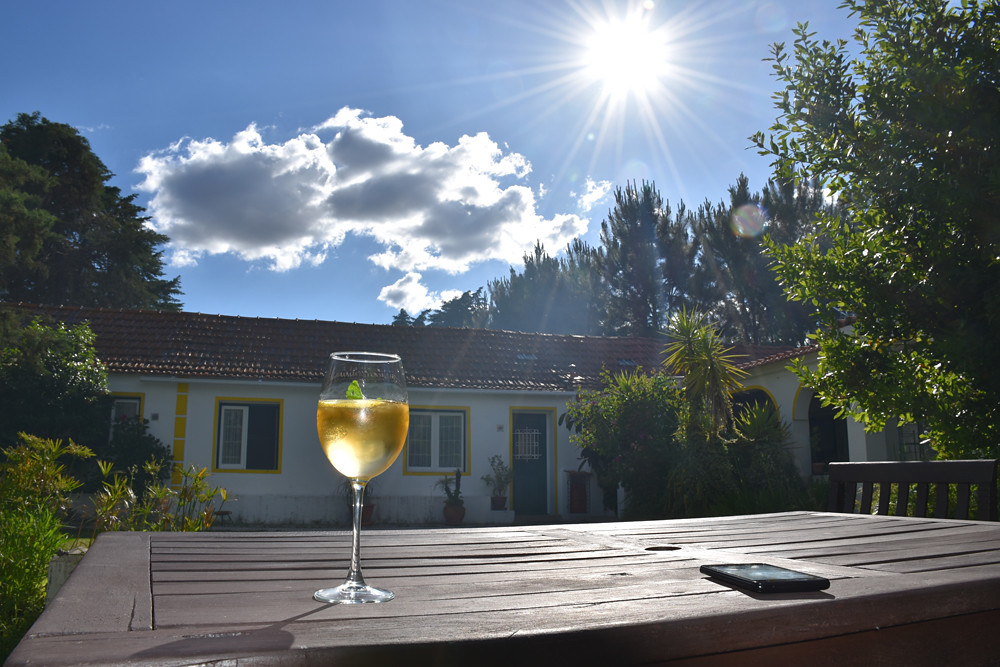It is 46C. My phone pings with warnings from the Portuguese Met Office about there being an extreme risk of fires. We will eat lunch outside, huddling under the shade of an umbrella which only partially brings relief from soaring temperatures, but we’ll only last about 20 minutes before we’re forced to scurry back inside to darkened rooms. Now I fully understand why many houses in hot countries don’t have picture windows. The Iberian Peninsula is broiling – possibly the record for the highest temperature in Europe (48C in Athens in 1977) will be broken. Somewhere on social media someone will comment “I hope the heatwave lasts till next week as I’ll be arriving on holiday…”
Their ‘perceived’ perfect climate is a nightmare.

Having spent 14 years in the Canary Islands we’ve written about the islands having an almost ideal climate (nowhere is perfect) many times. But it took a sizzling summer in a sauna to make us really appreciate what having a perfect climate means.
We might have sweated our way through a handful of dog days and nights during trips to the likes of Madrid, where cooling water gushed in fine sprays from the underside of cafe umbrellas. But that’s only an amuse-bouche compared to summers where, instead of living life outside, we hide in darkened rooms. Now we know exactly why the Canaries are considered to have a perfect climate; although it’s a label misunderstood by many who visit and even some who’ve made it home. When visiting scientists first spoke of the islands as having a near-perfect climate they weren’t referring to the areas which are now home to the most popular beach resorts.

To some, the term ‘perfect climate’ might mean year-round blue skies and hot temperatures. But to anyone living and, more importantly, working in a hot climate relentlessly high temperatures over a prolonged period are exhausting, as some in the UK might have discovered this summer. There’s a huge difference between basking in sunshine and toiling in it – manually or mentally.
The Canaries are known as being islands of eternal spring. Note – ‘spring’, not summer. The tourist board even has a website dedicated to the climate called, with some justification, the best climate in the world. The site talks about pleasant summers and mild winters. In winter months the average temperature is 18C compared with 8C in cities in southern Europe whilst in summer the average is 23C rising to 27C (with only occasional higher glitches) whilst southern Europe sizzles uncomfortably. It’s an easy and comfortable place to live, weather wise.

One of the ironies about the summer weather is whilst Spanish mainlanders flock to the pleasant temperatures of the Canary Islands, many British holidaymakers choose this time of year to avoid them, heading instead to the southern European climates locals have fled from.
What the Canary Islands’ website doesn’t highlight is the perfect climate means it rains now and again; the islands experience a decent amount of rainfall outside of summer. Sometimes of Biblical proportions. Mostly, but not exclusively, the rain affects higher parts and northern areas… which some view as a bad thing.

In the world of holidays, a perfect climate is one where there’s no rain, endless blues skies and never-ending hot temperatures. I’ve been there, got that sun-bleached tee-shirt. I remember our first holiday in Greece where ever day I pulled back the curtains like a child hoping Santa Claus had been and left me a cloudless sky. I was amazed when every morning dawned a blue one.
Jump forward to our first year in the north of Tenerife. After a wet November, rain throughout the rest of the winter was so scarce we stood spellbound at our back door on an April afternoon as light drops danced their way from the skies. For the first time, rain seemed like a long lost friend.

Over the years we came to understand the importance of the rains which bookended winter. Why most Canarios lived in the areas which were less popular with sunseekers. We were in on the secret, when visitors glowered at equally glum skies, a local poet/philosopher would write ‘bailamos bajo la lluvia’ (we dance in the rain) at the side of the motorway. We knew the reason in June on Gran Canaria, a shepherd we passed had a wide beam on his face. Rain is essential for a perfect climate… but not too much.

Since we left Britain I’ve developed a greater understanding of weather patterns and what numbers on a chart mean in reality. But I appreciate why there can be a different point of view about what constitutes a perfect climate between people who visit a location known for having good holiday weather and people who live there.
As a friend who lives on La Gomera remarked to us many years ago – “when it’s cloudy we know the sun will be back in a few days.” People on holiday don’t have that luxury.




Be the first to comment